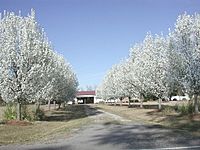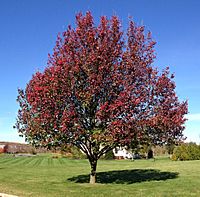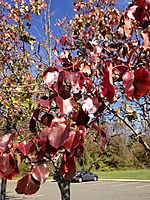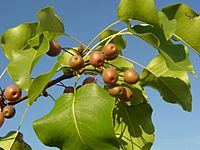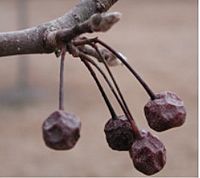Callery pear facts for kids
Quick facts for kids Callery pear |
|
|---|---|
 |
|
| Callery pear | |
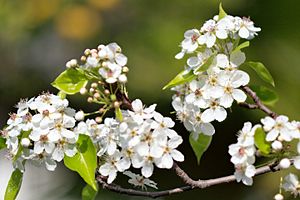 |
|
| Callery pear blossoms | |
| Scientific classification | |
| Genus: |
Pyrus
|
| Species: |
calleryana
|
| Synonyms | |
|
List
|
|
The Callery pear (scientific name: Pyrus calleryana) is a type of pear tree. It originally comes from China and Vietnam. This tree is part of the Rosaceae family, which also includes roses.
Many people know a specific type of Callery pear called 'Bradford'. This 'Bradford' pear is planted a lot in the United States. However, it is now often seen as an invasive species, meaning it spreads too much and can harm local plants.
Callery pear trees lose their leaves in autumn, which means they are deciduous. They can grow quite tall, usually between 5 to 8 meters (16 to 26 feet). Their shape is often like a cone or a rounded top. The leaves are oval and about 4 to 8 centimeters (1.5 to 3 inches) long. They are shiny and dark green on top. In a breeze, you can see their slightly lighter undersides.
In early spring, before the leaves fully grow, the trees produce many white flowers. These flowers have five petals and are about 2 to 2.5 centimeters (0.8 to 1 inch) wide.
The fruits of the Callery pear are small, less than one centimeter across. They are hard and almost woody. Birds usually eat them only after a frost makes them soft. This helps spread the seeds through bird droppings. In summer, the shiny foliage is dark green and very smooth. In autumn, the leaves turn bright colors. These colors can be yellow, orange, red, pink, purple, or bronze. Sometimes, a hard frost can stop the leaves from getting their full color if it happens too early.
Callery pears are very good at resisting diseases like fireblight. But some types, like 'Bradford', can be easily damaged by storms. Strong winds, ice, heavy snow, or broken branches can hurt or even kill them. This happens because they grow very fast.
The tree is named after Joseph-Marie Callery. He was a French expert on China who sent samples of the tree to Europe from China.
Contents
Growing Callery Pears
Many different types of Callery pear trees are sold. Some popular ones include 'Aristocrat', 'Autumn Blaze', 'Bradford', 'Capital', 'Chanticleer' (also called 'Cleveland Select'), 'New Bradford', 'Redspire', and 'Whitehouse'.
Callery Pears in the United States
The United States Department of Agriculture (USDA) first brought these trees to the U.S. in the mid-1960s. They were meant to be planted as pretty trees in gardens and parks. Landscapers liked them because they were cheap, easy to move, and grew fast.
In 1966, Lady Bird Johnson helped make the tree popular. She planted one in downtown Washington, D.C. The New York Times also praised the tree. They said it was almost perfect for landscaping.
In many parts of North America, especially the 'Bradford' type, these trees are widely planted. They can grow in different types of soil. Their shape can be oval or elliptical. However, they might become uneven if branches break off due to fast, unstable growth. Because of their neat shape when young, they were often used in places like streets and shopping centers.
Their white blossoms appear in early spring. They are very noticeable. Some people find their smell unpleasant, comparing it to rotting fish. In places like Pittsburgh, Pennsylvania, the leaves often stay green until mid-November. In warm autumns, their colors are bright. But in cold years, frost might kill the leaves before they can change color. In the southern U.S., Callery pears are usually reliable for autumn colors.
Why Callery Pears are Invasive
The 'Bradford' pear and other Callery pear types are considered invasive species in many eastern and midwestern parts of North America. This means they grow so well that they take over areas. They can push out native plants and trees. In the northeastern United States, wild Callery pears sometimes form large groups. They grow in old fields, along roads, and in other disturbed areas.
People plant Callery pears for their beauty. But the trees produce many fruits. Birds eat these fruits and then spread the seeds in their droppings. Different types of Callery pears usually cannot make fertile seeds by themselves. But if different types are planted close together (within about 100 meters or 300 feet), insects can carry pollen between them. This allows them to produce fertile seeds.
These seeds can then sprout and grow wherever they land. The new wild trees can then breed with each other. This helps the species spread even more. These wild plants often look different from the planted types. They might have an uneven shape or even thorns.
Callery pear trees are found growing wild in 152 counties across 25 states in the United States. Even though these wild plants are sometimes called "Bradford pear," they are actually wild descendants of many different Callery pear types. So, it's more correct to call them by the species name, Pyrus calleryana.
The 'Bradford' pear, in particular, has become a problem tree. It was liked for its neat, upright growth in small city spaces. But without careful pruning when young, its branches grow weak. This leads to many narrow, weak forks that break easily in storms. Because of this, and their short life expectancy (usually less than 25 years), many groups now suggest planting local native trees instead of 'Bradford' pears.
Uses of Pear Wood
Pear wood from any pear tree is known for being very fine-textured. It is used to make musical instruments, especially woodwind instruments. Thin sheets of pear wood, called veneer, are also used in nice furniture. Pear wood is also a favorite for making woodcuts for printing.
Callery pear trees have also been used as rootstock for grafting other pear types. This includes pears like Comice, Bosc, or Seckel, and especially Nashi pears. Pyrus calleryana was first brought to the United States in 1909 and 1916. This was largely due to the work of Frank N. Meyer, a plant explorer for the United States Department of Agriculture. He is also known for discovering the Meyer lemon. The trees were brought for farming experiments, long before people realized they could be used as ornamental plants in the 1950s.
See also
 In Spanish: Peral de Callery para niños
In Spanish: Peral de Callery para niños


